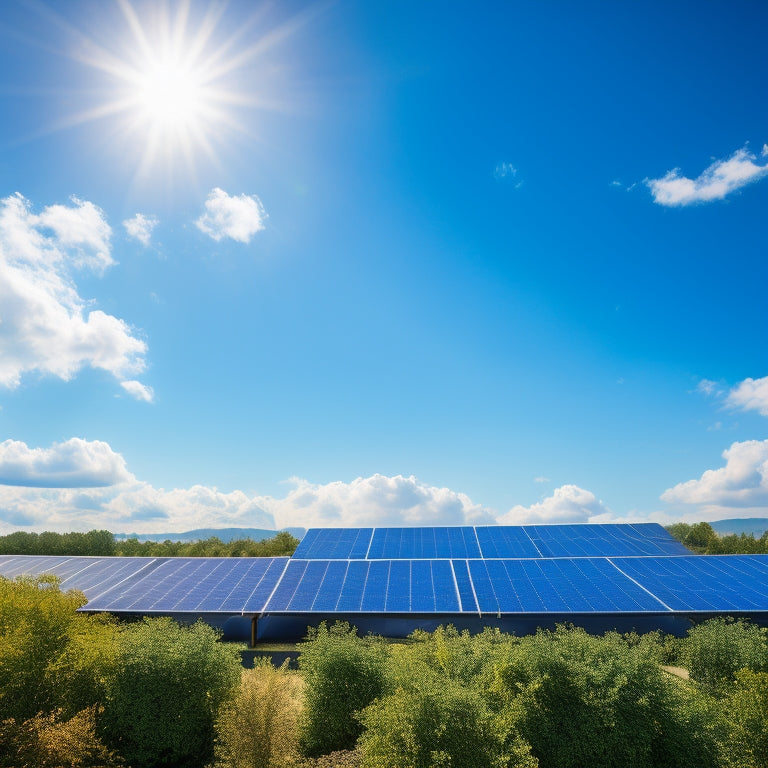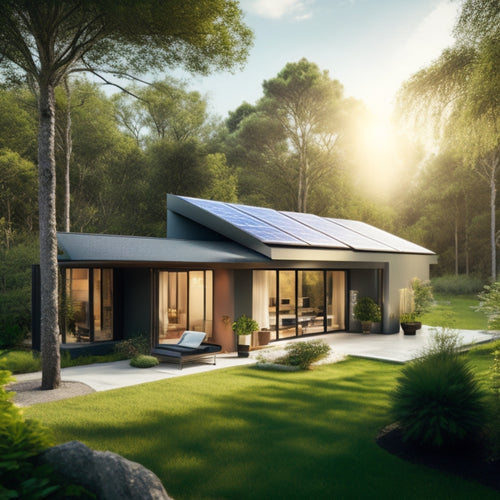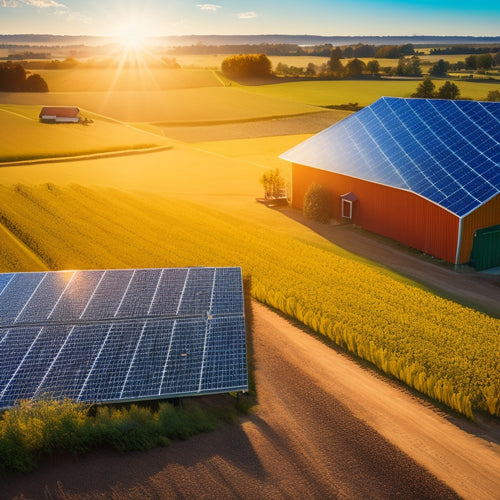
The 10 Best Solar Panels to Use for Maximum Savings
Share
When it comes to maximizing energy savings, you need the most efficient solar panels on the market. Top-rated monocrystalline options like SunPower X-Series, Panasonic HIT-240, and LG NeON 2 offer high efficiency and reliability. Polycrystalline panels provide a cost-effective alternative, suitable for both residential and commercial applications. Look for high-efficiency ratings above 20%, maximum power output, and advanced photovoltaic cells for optimal energy production. Additionally, consider durable brands like Panasonic and LG, and budget-friendly options that don't compromise on quality. By choosing the right solar panels, you'll be on your way to significant reductions in your electricity bills – and there's more to investigate in the world of solar energy optimization.
Key Takeaways
- For maximum savings, choose high-efficiency solar panels with ratings above 20% to generate more energy per unit area.
- Consider durable and reliable solar panels from reputable brands like Panasonic, LG, and SunPower for long-term performance.
- Assess your energy needs and installation constraints to select the right panel type, size, and configuration for your roof.
- Look for solar panels with advanced features like bifacial technology, high-efficiency cells, and strategic system design for optimal energy production.
- Evaluate budget-friendly options, government incentives, and financing plans to reduce upfront costs and maximize savings on electricity bills.
Top-Rated Monocrystalline Solar Panels
Three leading monocrystalline solar panels stand out for their exceptional efficiency and performance. As you consider investing in a solar panel system, you'll want to know that you're getting the best bang for your buck.
The SunPower X-Series Residential Solar Panel, the Panasonic HIT-240 Solar Panel, and the LG NeON 2 Solar Panel are top contenders. These panels boast high-efficiency ratings, with the SunPower X-Series reaching an impressive 22.8% efficiency.
When it comes to installation, make certain to follow proper installation tips, such as guaranteeing a secure and level mounting system. Proper maintenance practices are also vital, including regular cleaning and inspection to guarantee peak performance.
Best Polycrystalline Solar Panels
While monocrystalline solar panels boast exceptional efficiency, polycrystalline solar panels offer a more affordable option without sacrificing too much performance. You can still reap significant savings on your energy bills with polycrystalline panels, which are made from multiple silicon crystals.
Polycrystalline advantages include:
-
Cost-effectiveness: Polycrystalline panels are generally cheaper to produce than monocrystalline panels, making them a more budget-friendly option.
-
Durability: Polycrystalline panels are just as durable as monocrystalline panels, with similar lifespans and warranties.
-
Versatility: Polycrystalline panels can be used for both residential and commercial applications, making them a versatile option.
When considering polycrystalline solar panels, keep in mind installation considerations such as roof size, orientation, and shading.
Confirm you have a sufficient roof area to accommodate the panels, and consider consulting with a professional to determine the best installation layout.
High-Efficiency Solar Panel Options
When selecting high-efficiency solar panels, you'll want to take into account panel efficiency ratings, which measure the percentage of sunlight converted into electricity.
Look for panels with high efficiency ratings, typically above 20%, to maximize your energy output.
Additionally, pay attention to maximum power output, measured in watts (W), to guarantee your system can handle the electrical load.
Panel Efficiency Ratings
Your solar panel's efficiency rating considerably impacts the amount of electricity it can produce per hour of sunlight. This rating is a vital factor in determining how much power you can generate from your solar panel system.
With solar technology advancements, manufacturers have been able to increase efficiency ratings, resulting in more power output.
When comparing solar panels, it's important to understand efficiency comparison methods. Here are three key factors to evaluate:
-
Cell efficiency: This measures the efficiency of individual solar cells, which are the building blocks of a solar panel. Higher cell efficiency means more power output per cell.
-
Module efficiency: This measures the efficiency of the entire solar panel module, considering the interactions between cells. Module efficiency is a better indicator of real-world performance.
-
System efficiency: This measures the efficiency of the entire solar panel system, including inverters, wiring, and other components. System efficiency is the most thorough metric, but it's also the most complex to calculate.
Maximum Power Output
Higher efficiency ratings translate to more power output per hour of sunlight, and maximum power output is essential for homeowners and businesses seeking to minimize their energy bills.
You'll want to evaluate high-efficiency solar panels that can produce more power per unit area, reducing the overall system size and installation costs. With higher power output, you can also maximize your energy storage capacity, storing excess energy generated during the day for use during the night or on cloudy days.
When assessing solar panels for maximum power output, look for models with high wattage ratings, typically above 300 watts. These panels often feature advanced technologies like multi-busbar or shingled cells, which enable more efficient energy conversion.
Additionally, examine panels with high fill factors, which indicate a higher percentage of the panel's surface area is dedicated to energy production. By opting for high-efficiency solar panels, you can generate more power from a smaller system, reducing your energy bills and payback period.
Affordable Solar Panels for Homes
You're likely looking for solar panels that won't break the bank, and fortunately, budget-friendly options exist that can still provide cost-effective energy solutions for your home.
When searching for affordable solar panels, you'll want to take into account factors such as the type of photovoltaic cells used, the panel's wattage, and the manufacturer's warranty.
Budget-Friendly Options Exist
Going solar doesn't have to break the bank, as affordable options are now more accessible than ever. You can benefit from renewable energy without sacrificing your savings.
Affordable solar panels for homes have become a reality, making it possible for you to reduce your carbon footprint without breaking the bank.
Here are three ways you can take advantage of budget-friendly solar options:
-
Government Incentives: Take advantage of government incentives and tax credits that can greatly reduce the upfront cost of solar panel installation.
-
Affordable Installations: Opt for affordable solar panel installations that offer competitive pricing without compromising on quality.
-
Financing Options: Investigate financing options that allow you to pay for your solar panels in installments, making it easier to switch to renewable energy.
Cost-Effective Energy Solutions
Your pursuit of affordable solar panels for homes leads you to cost-effective energy solutions that can greatly reduce your electricity bills. By utilizing renewable energy from the sun, you can markedly lower your reliance on traditional power sources and contribute to sustainable living.
When evaluating cost-effective energy solutions, consider solar panels with high-efficiency ratings and durable construction. Look for panels with a minimum efficiency rating of 20% and a warranty of at least 25 years. This guarantees you'll generate maximum power while minimizing maintenance costs.
Additionally, assess the panel's temperature coefficient, which measures its performance in high-temperature conditions. A lower temperature coefficient indicates better performance in warm climates.
Most Durable Solar Panel Brands
High-efficiency solar panels are only as reliable as their construction, and a durable brand can make all the difference in maximizing your savings.
You want a brand that can withstand harsh weather conditions, last for decades, and maintain its performance over time.
To guarantee you're getting a durable solar panel, look for brands that undergo rigorous durability testing. This includes testing for thermal cycling, humidity, and UV exposure.
Here are three brands that stand out for their durability:
- Panasonic: Known for their high-efficiency solar panels, Panasonic undergoes some of the most stringent durability testing in the industry.
- LG: LG's solar panels are built to last, with a 25-year warranty and a proven track record of withstanding extreme weather conditions.
- SunPower: SunPower's solar panels are designed to maintain their performance over time, with a unique design that minimizes degradation.
When comparing brands, look for third-party certifications like IEC and UL, which verify that the solar panels meet international standards for durability and performance.
Solar Panels for Small Spaces
Optimizing your solar panel system for small spaces requires careful consideration of panel size, efficiency, and installation layout.
You'll want to maximize energy production while minimizing the footprint of your system. Look for space-saving technologies that allow you to fit more power into a smaller area. Compact solar solutions, such as high-efficiency panels with smaller frames, can help you achieve this goal.
When selecting solar panels for small spaces, prioritize high-efficiency models that can generate more power per square foot.
These panels often feature advanced cell designs and state-of-the-art materials that enhance energy output. Additionally, consider panels with slim profiles and sleek designs that can be easily integrated into tight spaces.
To further optimize your system, pay attention to installation layout.
You may need to get creative with your mounting configuration to fit all the panels you need. Luckily, many modern solar panels are designed with flexibility in mind, offering adjustable tilt angles and versatile mounting options.
Best Solar Panels for Camping
Mounted on a camper van or tent, solar panels can be a game-changing solution for campers seeking to stay off-grid for extended periods.
When choosing the best solar panels for camping, you'll want to prioritize portable, lightweight, and efficient options that can keep up with your energy demands.
Here are three key considerations for selecting the ideal camping solar panels:
-
Portability: Look for solar panels that are compact, foldable, and weigh less than 20 pounds. This will guarantee you can easily transport and set up your panels in any campsite.
-
Efficiency: Opt for high-efficiency solar panels (>20%) to maximize energy production in limited sunlight conditions. This is particularly important for camping in shaded or cloudy areas.
-
Compatibility: Consider solar panels that come with built-in solar chargers and are compatible with your camping accessories, such as batteries and inverters. This will streamline your off-grid energy setup and assure seamless integration.
Energy-Efficient Solar Panel Systems
You'll want to prioritize energy-efficient solar panel systems that boast higher energy conversion rates, as they can notably enhance your energy output.
These systems often feature advanced photovoltaic cells that minimize energy loss, ensuring you get the most out of your solar investment.
Higher Energy Conversion Rates
With the rise of energy-efficient solar panel systems, homeowners can now reap the benefits of higher energy conversion rates, translating to more significant savings on their electricity bills.
This means you can generate more power from the same amount of sunlight, making your investment in solar technology more worthwhile.
Higher energy conversion rates are achieved through solar technology advancements, such as:
-
Bifacial solar panels: These panels can capture energy from both the front and back sides, increasing energy output by up to 25%.
-
High-efficiency cells: Advanced cell designs and materials enable more efficient energy conversion, resulting in higher power output.
-
Optimized system design: Strategic system design and component selection guarantee maximum energy production and minimal losses.
Efficient Energy Harvesting Systems
Utilizing maximum energy from the sun requires an efficient energy collection system, which is where energy-efficient solar panel systems come into play. You want to guarantee that your solar panels are equipped with the latest solar technology advancements to capitalize on the most energy possible. An efficient energy harvesting system consists of high-quality solar panels, a reliable mounting system, and a state-of-the-art inverter.
| Component | Efficiency Feature |
|---|---|
| Solar Panels | High-efficiency cells with anti-reflective coating |
| Inverter | Maximum power point tracking (MPPT) for peak energy extraction |
| Mounting System | Adjustable tilt and angle for seasonal enhancement |
In addition to an efficient energy harvesting system, you'll also want to take into account energy storage solutions to store excess energy generated during the day for use during the night or on cloudy days. This guarantees a consistent and reliable power supply. By combining an efficient energy harvesting system with energy storage solutions, you'll be able to maximize your energy savings and reduce your reliance on the grid.
Budget-Friendly Solar Panel Kits
A homeowner on a tight budget can still make use of the power of the sun with budget-friendly solar panel kits.
These kits are designed to provide a cost-effective solution for homeowners who want to leverage solar energy without breaking the bank.
With DIY installation, you can save even more money on labor costs.
Here are 3 key considerations to keep in mind when choosing a budget-friendly solar panel kit:
-
Efficiency: Look for kits with high-efficiency solar panels that can generate more power per hour of sunlight.
-
Durability: Choose kits with durable components that can withstand harsh weather conditions and require minimal solar panel maintenance.
-
Certifications: Verify the kit meets industry standards and certifications, such as UL and IEC, to guarantee a safe and reliable installation.
Top Solar Panels for Commercial Use
Commercial properties can greatly reduce their energy expenses and carbon footprint by utilizing the power of solar energy. When it comes to commercial installations, you need high-efficiency solar panels that can maximize your energy output.
Look for panels with a high wattage capacity, such as the Trina Solar TALLMAX M10, which offers up to 545 watts of power. Other top contenders include the JA Solar JAM60S30, with an efficiency rate of 20.6%, and the Hanwha Q CELLS Q.PEAK DUO, boasting a 20.5% efficiency rate.
When considering commercial installation, it's crucial to factor in solar panel financing options. Many companies offer financing solutions, such as power purchase agreements (PPAs) or solar leases, which can help reduce upfront costs.
Additionally, commercial properties can benefit from tax incentives, such as the Solar Investment Tax Credit (ITC), which can help offset the cost of installation. By investing in high-quality solar panels and exploring financing options, you can greatly reduce your energy expenses and increase your bottom line.
Frequently Asked Questions
Can I Install Solar Panels on a Metal Roof?
You can install solar panels on a metal roof, leveraging its advantages like durability and ease of installation, but consider factors like panel weight, roof pitch, and clamping systems to guarantee a secure and efficient setup.
Do Solar Panels Work During Power Outages?
Like a guiding light in the dark, you wonder if solar panels shine during power outages; sadly, they don't - unless you're off the grid with battery storage, then you'll be lit up like a lighthouse, unaffected by the blackout.
Are Solar Panels Resistant to Hail Damage?
You're wondering if solar panels can withstand hailstorms; the answer is yes, many modern panels are designed with hail resistance in mind, boasting strong panel durability that can absorb impacts without compromising their energy-generating capabilities.
Can I DIY Install My Own Solar Panel System?
You can DIY install your own solar panel system, but be prepared to handle complex solar panel sizing calculations and obtain necessary installation permits, ensuring a safe and efficient setup that meets local building codes and utility regulations.
Do Solar Panels Increase My Property Value?
You're sitting on a goldmine, and solar panels are the key to releasing its value! Installing them can enhance your property's worth, and the increased property tax assessment will be offset by the significant energy savings you'll reap.
Conclusion
You've made it to the end of our extensive guide to the best solar panels for maximum savings. By now, you're equipped with the knowledge to choose the perfect panels for your needs. Did you know that, according to the International Energy Agency, solar power could become the largest source of electricity globally by mid-century? With the right solar panels, you'll be contributing to a sustainable future while saving big on your energy bills.
Related Posts
-

Top-Rated Solar Storage Solutions for Homeowners
When considering top-rated solar storage solutions, you're looking at systems that provide energy independence and si...
-

Off-Grid Solar Solutions for Sustainable Farming
Off-grid solar solutions can revolutionize your farming operations by providing energy independence and significant c...
-

Energy-Efficient Home Upgrades for Cost Reduction
To reduce costs with energy-efficient home upgrades, focus on essential improvements like smart thermostats, energy-e...


